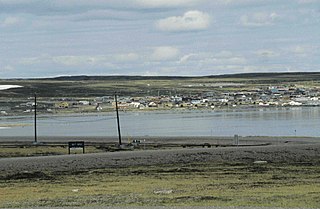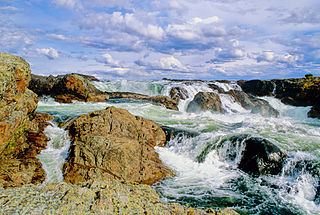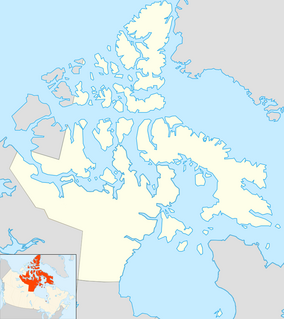
The Arctic Archipelago, also known as the Canadian Arctic Archipelago, is a group of islands north of the Canadian mainland.

Devon Island is an island in Canada and the largest uninhabited island on Earth. It is located in Baffin Bay, Qikiqtaaluk Region, Nunavut, Canada. It is one of the larger members of the Canadian Arctic Archipelago, the second-largest of the Queen Elizabeth Islands, Canada's sixth-largest island, and the 27th-largest island in the world. It comprises 55,247 km2 (21,331 sq mi) of Precambrian gneiss and Paleozoic siltstones and shales. The highest point is the Devon Ice Cap at 1,920 m (6,300 ft) which is part of the Arctic Cordillera. Devon Island contains several small mountain ranges, such as the Treuter Mountains, Haddington Range and the Cunningham Mountains. The notable similarity of its surface to that of Mars has attracted interest from scientists.

This is a list of the extreme points of North America: the points that are highest and lowest, and farther north, south, east or west than any other location on the continent. Some of these points are debatable, given the varying definitions of North America.
This is a list of the extreme points of The Americas, the points that are farther north, south, east or west than any other location on the continent. The continent's southernmost point is often said to be Cape Horn, which is the southernmost point of the Chilean islands. The Americas cross 134° of longitude east to west and 124° of latitude north to south.

Baker Lake is a hamlet in the Kivalliq Region, in Nunavut on mainland Canada. Located 320 km (200 mi) inland from Hudson Bay, it is near the nation's geographical centre, and is notable for being the Canadian Arctic's sole inland community. The hamlet is located at the mouth of the Thelon River on the shore of Baker Lake. The community was given its English name in 1761 from Captain William Christopher who named it after Sir William Baker, the 11th Governor of the Hudson's Bay Company.
Bearhole Lake Provincial Park is a provincial park in British Columbia, Canada, located 5 km east of the mining community of Tumbler Ridge, on the Alberta Plateau. Established in January 2001, the park includes 17,762 ha of land in the Boreal White and Black Spruce biogeoclimatic zones within the Kiskatinaw Plateau. It is transition zone with mixed wood forests including spruce, pine, and larch. Bearhole Lake, the headwaters of the Kiskatinaw River provides habitat for trumpeter swans, yellow perch, burbot, rainbow trout, and northern pike.

Lake Hazen is often called the northernmost lake of Canada, in the northern part of Ellesmere Island, Nunavut, but detailed maps show several smaller lakes up to more than 100 km (62 mi) farther north on Canada's northernmost island. Turnabout Lake is immediately northeast of the northern end of Hazen lake. Still further north are the Upper and Lower Dumbell Lakes, with Upper Dumbell Lake 5.2 km (3 mi) southwest of Alert, Canada's northernmost settlement on the coast of Lincoln Sea, Arctic Ocean.
South Dakota's 1st congressional district is now obsolete. It existed from 1913 to 1983.

The Kazan River, is a Canadian Heritage River located in Nunavut, Canada. The Dene name for the river was Kasba-tue meaning "white partridge river." The name was apparently changed to Kazan in the late 19th century due to the influence of Order of Mary Immaculate missionaries. The river headwaters are in northern Saskatchewan at Kasba Lake, and it flows north for about 1000 km (621 mi) before emptying into Baker Lake, on the opposite side of the mouth of the Thelon River. Along its course the river flows through several lakes, including Ennadai Lake and Yathkyed Lake, over the Kazan Falls, down a red sandstone gorge and through both boreal forest and tundra. It is the last section of the river, below Ennadai Lake, that is above the timber line and is designated a Canadian Heritage River.
North Lake is a reservoir 4 miles (6.4 km) north of Clarksville, Texas (USA) in Red River County. Its spillway has an elevation 430 feet (131 m). It lies in a heavily wooded area with hardwoods and pines.

Corrales de Duero is a municipality located in the province of Valladolid, Castile and León, Spain. According to the 2004 census (INE), the municipality has a population of 119 inhabitants.

Henik Lake is located in the Kivalliq Region of Nunavut, Canada. The lake is made up of two lakes, North Henik Lake and South Henik Lake with a narrows separating them. Of the two, North Henik Lake is the smaller with an area of 245 km2 (95 sq mi), while South Henik Lake has an area of 513 km2 (198 sq mi).
The Kaleet River effectively starts north of Lower Macdougall Lake in the Kitikmeot Region, Nunavut, Canada just east of Joe Lake, 66°16′31″N098°20′13″W. It is a small, silty river constituting the eastern boundary of the Queen Maud Gulf Bird Sanctuary. It is a main feeder river to Sherman Basin, 67°46′59″N097°34′59″W, at its final outlet. There is evidence of earlier Inuit presence in the form of inuksuit. There is also evidence of a more modern presence in the form of cairns. There is at least one cabin on the north side of the Kaleet, as it widens entering Sherman Basin.

The Lindstrom Peninsula is located on the southern coast of Ellesmere Island, a part of the Qikiqtaaluk Region of the Canadian territory of Nunavut. Across Baffin Bay to the south lies Devon Island. Harbour Fiord and Landslip Island are to the west, while the Grise Fiord is to the east. The highest peak on the peninsula is Mount Aqiatushuk 76°25′40″N083°15′00″W.
Huatlatlauca Municipality is a municipality in Puebla in south-eastern Mexico.
Fry Peak is a sharp-pointed peak which is the southernmost peak in the Welch Mountains, in Palmer Land, Antarctica. It was mapped by the United States Geological Survey in 1974, and was named by the Advisory Committee on Antarctic Names for Lieutenant Frederick M. Fry, U.S. Navy, a Flight Surgeon and member of the para-rescue team of U.S. Navy Squadron VXE-6 during Operation Deep Freeze 1969 and 1970.













